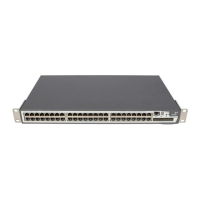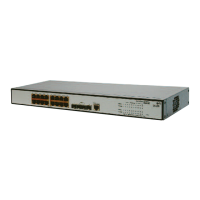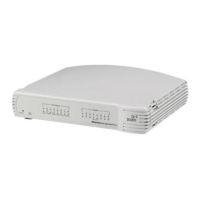Switch 4500 — Front View Detail 17
10BASE-T/
100BASE-TX Ports
The Switch 4500 has 24 or 48 auto-negotiating 10BASE-T/100BASE-TX
ports configured as Auto MDIX (cross-over). These ports automatically
provide the appropriate connection. Alternatively, you can manually set
these ports to 10BASE-T half-duplex, 10BASE-T full0-duplex, 100BASE-TX
half-duplex or 100BASE-TX full-duplex. The maximum segment length is
100 m (328 ft) over Category 5 twisted pair cable.
Gigabit Ports The Switch 4500 26 Port has two 1000BASE-X SFP ports and two
10/100/1000BASE-T ports, which are implemented as dual personality
combination ports pairing one 1000BASE-X and one 10/100/1000BASE-T
port. Only one port in each pair can be enabled at any one time.
The Switch 4500 50 Port, 50 Port PWR, and 26 Port PWR models each
have four 1000BASE-X Small Form Factor Pluggable (SFP) ports. These
also are implemented as two pairs of dual personality combination ports.
The port pairings of the 26-Port PWR model are: Port 25 with Port 27;
Port 26 with Port 28. The port pairings of the 50-Port models are: Port 49
with Port 51; Port 50 with Port 52. Only one port in each pair can be
enabled at any one time.
Two 1000BASE-T SFP modules are inlcuded with these switches and can
be used for uplinks or stacking using copper Ethernet cabling. While
usable in any of the SFP ports, 3Com recommends these SFP modules be
installed in the two right-most ports of the switches (27/28 or 51/52).
SFP (Small Form Factor Pluggable, or mini-GBIC) ports support fiber
Gigabit Ethernet short-wave (SX), long-wave (LX), long-haul (LH70) and
copper (T) SFP Transceivers in any combination. This offers you the
flexibility of using SFP transceivers to provide connectivity between the
Switch and remote 1000 Mbps workgroups.
The default state for these ports is auto-negotiation enabled, where the
speed, duplex and flow control modes are negotiated. As the speed and
duplex modes are fixed by the media type, only the flow control is
negotiated with the link partner. Alternatively, auto-negotiation can be
disabled (except 1000BASE-T which auto-negotiation is mandatory) and
the flow control setting can be manually configured.
Console Port The console port allows you to connect a terminal and perform remote or
local out-of-band management. As the console port on the Switch is an
RJ-45 port, you will need to connect an RJ-45 to DB9 converter cable to a
standard null modem cable in order to connect a terminal.

